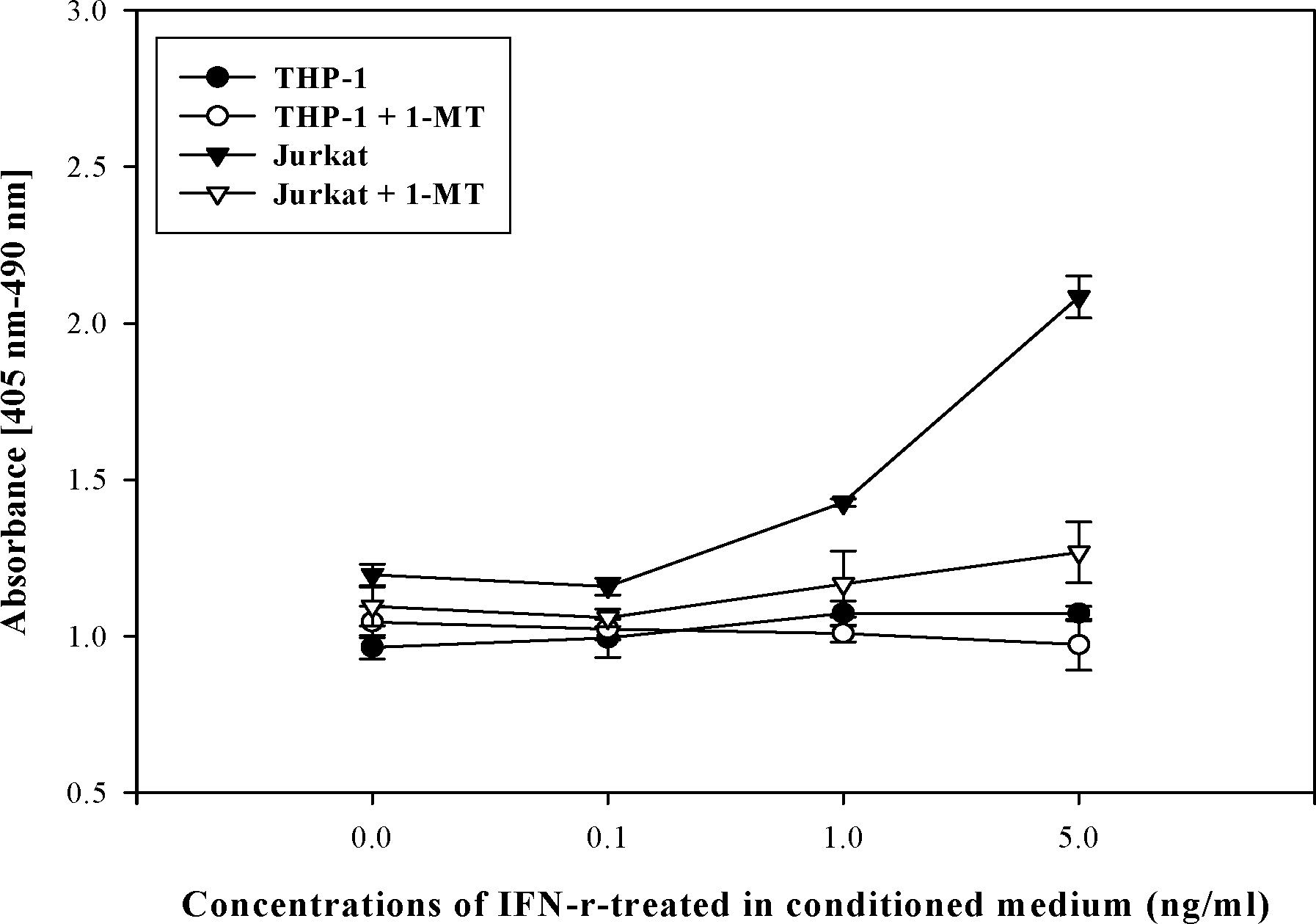J Korean Ophthalmol Soc.
2007 Aug;48(8):1126-1133.
Expression of Local Immunosuppressive Factor, Indoleamine 2,3-dixygenase, in Human Coreal Cells
- Affiliations
-
- 1Department of Ophthalmology, College of Medicine, Chung-Ang University, Seoul, Korea. jck50ey@kornet.net
Abstract
-
PURPOSE: To identify the localization of indoleamine 2,3-dioxygenase (IDO) in human corneal cells and to evaluate its ability to act as a local immunosuppressive factor.
METHODS
The expression profile of IDO was obtained with RT-PCR and Western blot of in a primary culture of human corneal cells (fibroblasts, epithelial cells and endothelial cells). In order to investigate the immunosuppressive function of IDO, immune cells were cultured in a human corneal cell-conditioned medium, and their prolifleration was identified by the MTT assay. Moreover, apoptotic effects of IDO in immune cells treated with IFN-gamma were also investigated with apoptosis ELISA.
RESULTS
Among the three different types of human corneal cells analyzed, mRNA and protein expression of IDO was observed only in human corneal fibroblasts. Immune cells cultured in a human corneal fibroblast-conditioned medium showed inhibited proliferation. Moreover, IFN-gamma-induced expression of IDO significantly enhanced apoptotic ability in a dose-depandant manner.
CONCLUSIONS
Our results suggest that human corneal fibroblasts are relatively immuno-resistant and that expression of IDO may be one of the factors involved in the immune tolerance observed in corneal grafts.
MeSH Terms
Figure
Reference
-
References
1. Higuchi K, Hayaishi O. Enzymic formation of D-kynurenine from D-tryptophan. Arch Biochem Biophys. 1967; 120:397–403.
Article2. Dai W, Gupta SL. Regulation of indoleamine 2,3-dioxygenase gene expression in human fibroblasts by interferon-Y. Upstream control region discriminates between interferon-Y and interferon-Q. J Biol Chem. 1990; 265:19871–7.3. Carlin JM, Borden EC, Sondel PM, et al. Interferon-inuced indoleamine 2,3-dioxygenase activity in human mononuclear phagocytes. J Leukoc Biol. 1989; 45:29–34.4. Hwu P, Du MX, Lapointe R, et al. Indoleamine 2.3-dioxygenase production by human dendritc cells results in the inhibition of T cell proliferation. J Immunol. 2000; 164:3596–9.5. Taylor MW, Feng GS. Relationship between interferon-Y, indoleamine 2,3-dioxygenase, and tryptophan catabolism. FASEB J. 1991; 5:2516–22.6. Yoshida R, Hayaishi O. Induction of pulmonary indoleamine 2.3-dioxygenase by intraperitoneal injection of bacterial lipopolysaccharide. Proc Natl Acad Sci U S A. 1978; 75:3998–4000.
Article7. Bianchi M, Bertini R, Ghezzi P. Induction of indoleamine 2.3-dioxygenase by interferon in mice: A study with different recombinant interferons and various cytokines. Biochem Biophys Res Commun. 1988; 152:237–42.8. Munn DH, Zhou M, Attwood JT, et al. Prevention of allogeneic fetal rejection by tryptophan catabolism. Science. 1998; 281:1191–3.
Article9. Munn DH, Shafizadeh E, Attwood JT, et al. Inhibition of T cell proliferation by macrophage tryptophan catabolism. J Exp Med. 1999; 189:1363–72.
Article10. Mellor AL, Munn DH. Tryptophan catabolism and T-cell tolerance: immunosuppression by starvation? Immunol Today. 1999; 20:469–73.
Article11. Li Y, Tredget EE, Kilani RT, et al. Expression of indoleamine 2.3-dioxygenase in dermal fibroblasts functions as a local immunosuppressive factor. J Invest Dermatol. 2004; 122:953–64.
Article12. Uyttenhove C, Pilotte L, Theate I, et al. Evidence for a tumoral immune resistance mechanism based on tryptophan degradation by indoleamine 2,3-dioxygenase. Nat Med. 2003; 9:1269–74.
Article13. Mellor AL, Keskin DB, Johnson T, et al. Cells expressing indoleamine 2,3-dioxygenase inhibit T cell resoponses. J Immunol. 2002; 168:3771–6.14. Friberg M, Jennings R, Alsarraj M, et al. Indoleamine 2,3-dioxygenase contributes to tumor cel evasion of T cell-mediated rejection. Int J Cancer. 2002; 101:151–5.15. Koizumi N, Fullwood NJ, Bairaktaris G, et al. Cultivation of corneal epithelial cells on intact and denuded human amniotic membrane. Invest Ophthalmol Vis Sci. 2000; 41:2506–13.16. Larkin DFP, Beutelspacher SC, George AJT. Expression and function of indoleamine 2,3-dioxygenase in murine cornea. Invest Ophthalmol Vis Sci (ARVO E-Abstract). 2005; 46:3587.17. Lee GK, Park HJ, Macleod M, et al. Tryptophan deprivation ensitizes activated T cells to apoptosis prior to cell division. Immunology. 2002; 107:452–60.18. Morita T, Saito K, Takermura M, et al. 3-hydroxyanthranilic acid, an L-tryptophan metabolite, induces apoptosis in monocyte-derived cells stimulated by interferon-gamma. Ann Clin Biochem. 2001; 38:242–51.
- Full Text Links
- Actions
-
Cited
- CITED
-
- Close
- Share
- Similar articles
-
- The role of placental indoleamine 2,3-dioxygenase in human pregnancy
- Suppression of in vitro murine T cell proliferation by human adipose tissue-derived mesenchymal stem cells is dependent mainly on cyclooxygenase-2 expression
- Expression of COX-2 and IDO by Uteroglobin Transduction in NSCLC Cell Lines
- Induction of Indoleamine 2,3-dioxygenase by Pre-treatment with Poly(I:C) May Enhance the Efficacy of MSC Treatment in DSS-induced Colitis
- Overexpression of indoleamine 2,3-dioxygenase correlates with regulatory T cell phenotype in acute myeloid leukemia patients with normal karyotype





